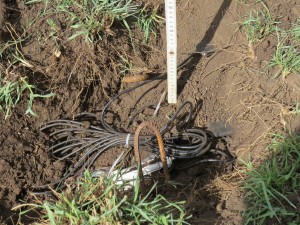Serengeti hotspots
Hotspots are temporally stable swards of nutrient-rich, fast-growing grasses that exist within the otherwise spatiotemporally dynamic savanna. Because of their persistence in the landscape and tendency to attract populations of resident herbivores, hotspot sites have been of great interest to researchers, who have long wondered what drives their creation, maintenance, and spatial distribution. Most recently, studies indicate that herbivore modification of soils plays an important role. We have installed water potential sensors* at hotspots throughout the Serengeti ecosystem to observe how the congregation of resident large-bodied herbivores at hotspots affects soil moisture dynamics, and subsequently, plant community composition.

Kathleen and Jerry (field assistant) complete exclosure construction at one of the Decagon study field sites.
*This project is funded by a Decagon G.A. Harris Research Instrumentation Fellowship. Read more about the funded project by clicking here.
Selected literature:
Arnold, Stephen G, Todd M Anderson, and Ricardo M Holdo. 2014. “Edaphic , Nutritive , and Species Assemblage Differences between Hotspots and Matrix Vegetation : Two African Case Studies.” Biotropica 46 (4): 387–394.
Veldhuis, Michiel P., Ruth a. Howison, Rienk W. Fokkema, Elske Tielens, and Han Olff. 2014. “A Novel Mechanism for Grazing Lawn Formation: Large Herbivore-Induced Modification of the Plant-Soil Water Balance.” Journal of Ecology


